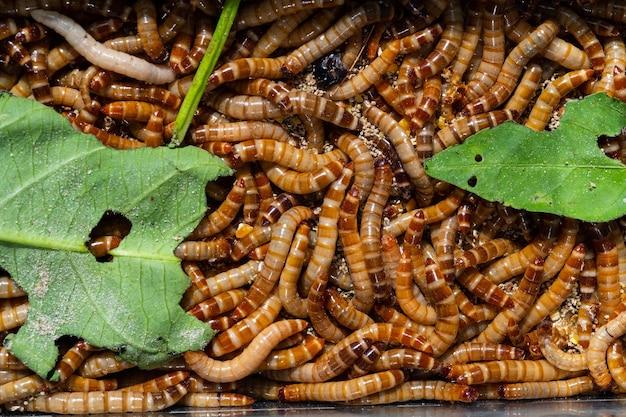Termites are among the most destructive pests that can infest your home. Phoenix, Arizona, like any other region, is not immune to termite infestations. Homeowners in Phoenix often wonder if they have termites and what to do in case their property is invaded.
So, does Phoenix have termites? The short answer is yes. Arizona is home to several termite species, including the desert subterranean termite, which is the most common species in the Phoenix area.
But, here’s the real question – do all Arizona homes have termites? The answer is no. Arizona has areas with higher termite activity compared to others. However, that doesn’t mean that homes in these areas are guaranteed to experience termite infestations.
Wondering what termites in Phoenix look like? Termites have a similar appearance to ants, but the two are entirely different pests. Termites have straight antennae, a broad waist, and equal-sized wings, while ants have elbowed antennae, a slender waist, and wings of different sizes.
In this comprehensive blog post, we discuss all you need to know about Phoenix termites. From the signs of termite infestation to the best termite treatment options, we’ve got you covered. Keep reading to learn more!
Phoenix Termites: Everything You Need to Know
If you’re a homeowner in Phoenix, Arizona, then termites are likely a cause of concern for you. These small insects can cause serious damage to your home and property, leading to expensive repairs and even structural issues.
How to Identify Phoenix Termites
Termites are often confused with ants, but there are some key differences between the two. Termites have straight antennae, a broad waist, and two pairs of wings that are equal in length. They also have a straight, beaded appearance to their bodies. Ants, on the other hand, have elbowed antennae, a narrow waist, and two pairs of wings that are different in length. They also have a pinched appearance to their bodies.
Signs of a Termite Infestation in Phoenix
Some common signs of a termite infestation include mud tubes on the exterior of your home, winged termites (also known as swarmers) inside your home, and damaged wood or walls. You may also notice discarded wings near windows or doors.
Taking Action Against Phoenix Termites
If you suspect a termite infestation in your home, it’s important to take action as soon as possible. Contact a professional exterminator to identify the extent of the infestation and recommend appropriate treatment options. Depending on the severity of the infestation, treatment may include baits, liquid treatments, or fumigation.
Preventing Phoenix Termite Infestations
Prevention is key when it comes to termites. To prevent a termite infestation, make sure to keep gutters clean and free of debris, eliminate moisture sources inside and outside your home, and remove any dead wood or tree stumps on your property. You can also invest in termite-resistant materials when building or renovating your home.
In conclusion, termites are a common concern for homeowners in Phoenix, Arizona. By learning how to identify, prevent, and treat termite infestations, you can protect your home and property from costly damage.
Does Phoenix Have Termites
If you live in Phoenix, you may be wondering if your home is safe from termites. Unfortunately, the answer is no. Phoenix is home to several species of termites, including the notorious subterranean termite.
What Types of Termites Are in Phoenix
As mentioned, subterranean termites are one of the most common types found in Phoenix. These termites live in underground colonies and work their way up into homes through cracks and other openings. There are also drywood termites, which can infest wood that is above ground, and dampwood termites, which thrive in moist, decaying wood.
How Can I Tell If I Have Termites in My Home
There are several signs that you may have termites in your home. These include:
- Piles of discarded wings, as termites shed their wings after finding a mate and establishing a colony
- Mud tubes on the exterior of your home, which termites use to travel between their colony and their food source
- Wood that sounds hollow when tapped
- Cracked or bubbling paint on wood surfaces, which may indicate termite damage underneath
If you suspect you have termites, it’s important to act quickly. Termites can cause significant damage to your home’s structure, and the longer you wait, the more expensive it may be to repair.
How Can I Prevent Termite Infestations
Preventing termite infestations is key to protecting your home. Here are some tips to keep termites at bay:
- Keep wood, including firewood and lumber, away from your home’s foundation.
- Fix any leaks or moisture problems in and around your home to prevent dampwood termites.
- Seal any cracks or openings in your home’s foundation and exterior walls.
- Have your home inspected by a professional termite exterminator annually.
By taking these steps, you can help prevent termites from infesting your home and potentially causing costly damage. Remember, prevention is key when it comes to termites.
In conclusion, Phoenix does have termites, and homeowners need to be vigilant to protect their property. By understanding the different types of termites and their behaviour, along with taking preventive measures, you can avoid termite infestations and maintain a pest-free home.
Are There Termites in Arizona
If you’re a homeowner in Phoenix, the thought of termites eating away at your home might be a scary one. But just how common are termites in Arizona?
The Short Answer
Yes, termites do exist in Arizona, including Phoenix. In fact, Arizona is home to several termite species, including subterranean, drywood, and dampwood termites.
Subterranean Termites
Subterranean termites are the most common type of termite found in Arizona. They typically live underground and build mud tubes to travel up to their food source: the cellulose material found in wood. These termites are known to cause significant damage to homes, and infestations can be challenging to detect.
Drywood Termites
Drywood termites, as their name suggests, live in dry wood. They don’t require contact with the soil and can fly to new locations to set up their colonies. While not as commonly found in Arizona as subterranean termites, they can still cause significant damage to homes.
Dampwood Termites
Dampwood termites are not as common in Arizona as subterranean or drywood termites. They prefer moist wood and are typically found in areas with high humidity levels. These termites can cause significant damage to homes and are often found in structures with water damage.
While termites are present in Arizona, and specifically Phoenix, there are ways to protect your home from infestation. Regular inspections, proper maintenance, and keeping wood away from your home’s foundation can all help to prevent an infestation. If you suspect you have a termite problem, it’s best to contact a professional pest control company to evaluate the situation and provide treatment options.
Do All Arizona Homes Have Termites
Termites are a common problem in Arizona due to its warm, dry climate, which makes it an ideal environment for these pesky insects. Many homeowners wonder if they have to worry about termites and if their homes are at risk. In this section, we will explore the prevalence of termites in Arizona and whether all homes are at risk.
Understanding the Prevalence of Termites in Arizona
Termites are a significant problem in Arizona, with many homes being infested by these destructive insects every year. In fact, Arizona is one of the top states for termite infestations in the United States. Despite this, not all homes in Arizona have termites, and not all homes are equally at risk of termite infestations.
Factors That Determine Termite Risk
The risk of termite infestations varies depending on several factors, including the type of termite, the age of the home, and its construction. For example, homes that are built in areas with a high concentration of trees or near wooded areas are more likely to have termites. Homes that are older than 20 years are also more likely to have termites. Additionally, homes that are built using wood frames and have a lot of wood-based materials are also more at risk for termite infestations.
Protecting Your Home
If you’re concerned about termites, the best thing you can do is be proactive about protecting your home. Here are a few steps you can take:
- Schedule regular termite inspections: A professional termite inspection can help you identify any potential issues before they become a more significant problem.
- Reduce moisture: Termites thrive in moist environments, so reducing moisture around your home can help reduce the risk of an infestation. Fix any leaks, address drainage issues, and ensure proper ventilation.
- Remove wood from around your home: If you have piles of wood or other wood-based materials near your home, you could be providing a food source for termites. Remove wood piles and store firewood away from your house.
- Use termite-resistant building materials: If you’re building a new home or doing renovations, consider using materials that are resistant to termites, such as concrete, steel, or pressure-treated wood.
In conclusion, not all homes in Arizona have termites, but many are at risk. By understanding the factors that contribute to termite infestations and taking steps to protect your home, you can reduce the risk of an infestation and enjoy peace of mind.
What Do Phoenix Termites Look Like
Termites are small, ant-like insects that are known for feeding on wood and causing millions of dollars of property damage every year in Phoenix. If you want to know if you have a termite problem or need to identify the termites in your home or property, then it’s essential to know what they look like.
Physical Appearance Of Phoenix Termites
In Phoenix, termites come in different species and sizes. However, the most common species are the subterranean and drywood termites. Subterranean termites are often pale, white, or light brown, while drywood termites are usually reddish-brown to black.
Termites have straight antennae and transparent wings that are equal in size and twice as long as their bodies. They also have a long, narrow waist with a broad head and mandibles used for biting and chewing wood.
Differentiating Termites From Other Insects
It’s crucial to differentiate termites from other insects, especially ants, which have a similar appearance. Unlike termites, ants have a distinct waistline, curved antennae, and front wings that are longer than their hind wings. Additionally, termites have straight antennae, a thick, uniform waistline, and two translucent wings that are equal in size.
Signs Of A Termite Infestation
If you suspect a termite infestation in your home or property, there are several signs to look out for. These include mud tubes, discarded wings, termite droppings, and damaged wood.
Mud tubes are distinctive tunnels made by subterranean termites that lead them from soil to wood. Discarded wings, on the other hand, are usually found near windows, doors, and other light sources that attract termites during their swarming season.
Termite droppings, also known as frass, look like small wood pellets and are typically found near termite feeding sites. Finally, damaged wood has a distinct honeycomb pattern that termites create as they eat through the wood.
In summary, Phoenix termites are small, ant-like insects with straight antennae, a narrow waistline, and two equal-sized, translucent wings. Differentiating termites from other insects such as ants can be challenging, but features of straight antennae, uniform waistline, and equal-sized wings can help you identify them correctly.
Remember that recognizing the signs of a termite infestation early is crucial. If you notice any of the signs mentioned above, contact a pest control specialist to inspect your property and develop a termite control plan immediately.



